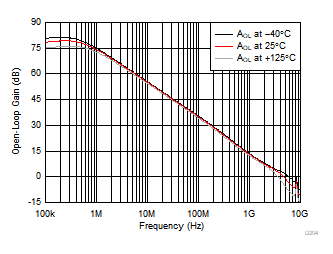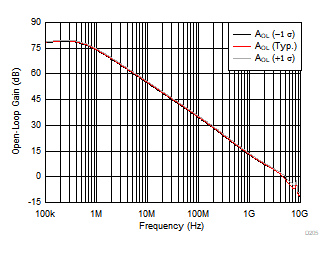ZHCSMN4 February 2021 OPA858-Q1
PRODUCTION DATA
- 1 特性
- 2 应用
- 3 说明
- 4 Revision History
- 5 Pin Configuration and Functions
- 6 Specifications
- 7 Parameter Measurement Information
- 8 Detailed Description
- 9 Application and Implementation
- 10Power Supply Recommendations
- 11Layout
- 12Device and Documentation Support
- 13Mechanical, Packaging, and Orderable Information
8.3.3 Wide Gain-Bandwidth Product
Figure 6-10 shows the open-loop magnitude and phase response of the OPA858-Q1. Calculate the gain bandwidth product of any op amp by determining the frequency at which the AOL is 60 dB and multiplying that frequency by a factor of 1000. The second pole in the AOL response occurs before the magnitude crosses 0 dB, and the resultant phase margin is less than 0°. This indicates instability at a gain of 0 dB (1 V/V). Amplifiers that are not unity-gain stable are known as decompensated amplifiers. Decompensated amplifiers typically have higher gain-bandwidth product, higher slew rate, and lower voltage noise, compared to a unity-gain stable amplifier with the same amount of quiescent power consumption.
Figure 8-5 shows the open-loop magnitude (AOL) of the OPA858-Q1 as a function of temperature. The results show minimal variation over temperature. The phase margin of the OPA858-Q1 configured in a noise gain of 7 V/V (16.9 dB) is close to 55° across temperature. Similarly Figure 8-6 shows the AOL magnitude of the OPA858-Q1 as a function of process variation. The results show the AOL curve for the nominal process corner and the variation one standard deviation from the nominal. The simulated results suggest less than 1° of phase margin difference within a standard deviation of process variation when the amplifier is configured in a gain of 7 V/V.
One of the primary applications for the OPA858-Q1 is as a high-speed transimpedance amplifier (TIA), as Figure 9-4 shows. The low-frequency noise gain of a TIA is 0 dB (1 V/V). At high frequencies the ratio of the total input capacitance and the feedback capacitance set the noise gain. To maximize the TIA closed-loop bandwidth, the feedback capacitance is typically smaller than the input capacitance, which implies that the high-frequency noise gain is greater than 0 dB. As a result, op amps configured as TIAs are not required to be unity-gain stable, which makes a decompensated amplifier a viable option for a TIA. What You Need To Know About Transimpedance Amplifiers – Part 1 and What You Need To Know About Transimpedance Amplifiers – Part 2 describe transimpedance amplifier compensation in greater detail.
 Figure 8-5 Open-Loop Gain vs Temperature
Figure 8-5 Open-Loop Gain vs Temperature Figure 8-6 Open-Loop Gain vs Process Variation
Figure 8-6 Open-Loop Gain vs Process Variation